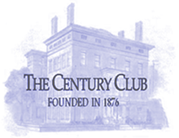Brief History
On March 5, 1866, Daniel Willard Fiske and Andrew D. White founded the Onondaga Club. It was the first social club organized in Syracuse and its purpose was to create an association for literary and recreational purposes. Within a few weeks of its founding, membership grew to 100 strong. As a select group of community leaders, businessmen and professionals, membership remained at 100 for the next ten years. On September 13, 1876, a new charter was drawn and the members of the Onondaga Club became the charter members of The Century Club. The Onondaga Club faded away and The Century Club carried on in its stead, its membership intact.
In 1891, another social club was formed under the name of the Players' Club. Its purpose was to encourage the theatre and arts. In 1894, the Players' Club changed its name to the Syracuse Club. By 1900, many of the members of The Century Club were also members of the Syracuse Club and the two clubs decided to merge, leaving The Century Club as the surviving entity.
Major Moses Dewitt Burnet, a prominent Syracuse businessman, built the present clubhouse at James and North Townsend streets in about 1842. It was occupied as his residence and rivaled the city's best homes. In 1881, the residence was acquired by The Century Club for its clubhouse. A 21-step staircase led from James Street to the entrance on the second floor and was one of the club's distinguishing features. Over time, some members found navigating those lofty heights difficult and in 1890 the front entry staircase was removed and a front door entrance was added to the ground level.
In 1890, the ground level was converted from a residence for the Club steward to member-use rooms and included a café, billiard room and bar. In 1912, a rear section was added to the structure to enlarge the clubhouse due to increased usage and demand by the Club's growing membership. During Prohibition, a bank of lockers was added to the barroom and keys were provided to each member; these lockers can be seen today. (The lockers were sealed at the end of Prohibition only to be opened 100 years later.) In 1996, the former billiard room was converted to a banquet hall and renamed the Century Room. In 1999, an addition was added to the west façade of the building to accommodate a new kitchen, freezer room and storage area.
Many prominent local, state and national names have been associated with The Century Club as members or guests. Attorney William C. Ruger was the first president of the original Onondaga Club and had as his guests during the inaugural year President Andrew Johnson, General Ulysses S. Grant, Admiral David Farragut, General George A. Custer and Secretary of State William Seward of Auburn. In later years, the clubhouse would be visited by President Herbert Hoover and a number of United States Senators and Congressmen and many prominent political, professional and business leaders from its own ranks.
Dr. Willis H. Carrier of Carrier Corporation, James Pass of Syracuse China, Huntington B. Crouse of Crouse-Hinds Corporation, Frederick R. Hazard of Solvay Process, Herbert H. Franklin of Franklin Air-Cooled Automobile and John Marsellus of Marsellus Casket Company were just some of the prominent businessmen who were club members. A number of published authors including Edward Noyes Westcott, Forbes Heermans, Harold MacGrath, E. Alexander Powell, Edward I. Rice, William A. Cowie, John F. Luchsinger Jr., and Timothy J. Green were also well-known Century Club members.
Several Century Club members have also served on New York State's highest court, the Court of Appeals, either as Chief Judge or Associate Judge. Among them are George F. Comstock, Charles Andrews, William C. Ruger, Frank H. Hiscock, Edmund H. Lewis, William S. Andrews, Irving G. Vann and Stewart F. Hancock, Jr.
Three Century Club members including Horace White, Nathan L. Miller and Edward Schoeneck have occupied the New York State governor's mansion as well.
The Century Club has been a vibrant part of our community for over 140 years. Its members come from all walks of life and represent excellence in their businesses and professions. Today's members proudly carry on the Club's history and tradition.

